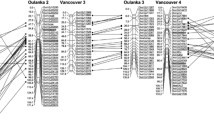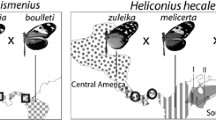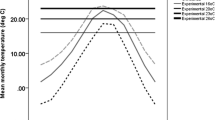Abstract
The impact of intraspecific hybridisation on fitness and morphological traits depends on the history of natural selection and genetic drift, which may have led to differently coadapted gene-complexes in the parental populations. The divergence at neutral and non-neutral loci between populations can be evaluated by estimating FST and QST respectively, and hence give an estimate of drift and selection in the populations. Here we investigate (1) whether divergence between populations in quantitative traits (wing size and shape) can be attributed to selection or drift alone, (2) The impact of intraspecific hybridisation on estimators for divergence at neutral (FST) and non-neutral loci (QST) in hybrids, (3) If measurement of shape is more informative than size in order to detect divergence in quantitative traits between populations. The aims were addressed by performing two hybridisations between three populations of Drosophila buzzatii, one between populations from Argentina and the Canary Islands (separated for 200 years), and the other between populations from Argentina and Australia (separated for 80 years). We observed the highest divergence at neutral loci between the Argentinean and Canary Island populations, but highest morphological divergence between the Argentinean and Australian populations, indicating that natural selection is acting on the wings. Divergence based on QST measures in the hybrids was sensitive towards increased phenotypic variance (σ2p) within groups and should be used with care when σ2p of populations differ. Our results indicate that measures of shape give a better estimate of divergence at the underlying quantitative traits loci than measures of size.

Similar content being viewed by others
References
Amos W, Balmford A (2001) When does conservation matter? Heredity 87:257–265
Andersen DH, Pertoldi C, Scali V, Loeschcke V (2002) Intraspecific hybridization, developmental stability and fitness in Drosophila mercatorum. Evol Ecol Res 4:603–621
Charmantier A, Garant D (2005) Environmental quality and evolutionary potential: lessons from wild populations Proc R Soc London, Ser. B 272:1415–1425
Dahlgaard J, Hasson E, Loeschcke V (2001) Behavioural differentiation in oviposition activity in Drosophila buzzatii from highland and lowland populations in Argentina: plasticity or thermal adaptation? Evolution 55:738– 747
Doyle JJ, Doyle JL (1987) A rapid DNA isolation procedure for small amounts of fresh leaf tissue. Phytochem Bull 19:11–15
Fisher RA (1958) The genetical theory of natural selection. 2nd edn. Dover Press, N.Y
Fontdevila A (1991) Colonizing species of Drosophila. In: Hewitt GH, Johnston AWB, Young JPW (eds) Molecular techniques in taxonomy. Springer Verlag, Heidelberg pp 249–269
Frydenberg J, Pertoldi C, Dahlgaard J, Loeschcke V (2002) Genetic variation in original and colonizing Drosophila buzzatii populations analysed by microsatellites loci isolated with a new PCR screening method. Mol Ecol 11:181–190
Goudet J, Martin G (2007) Under neutrality, QST< = FST when there is dominance in an island model. Genetics: online early
Goudet J, Büchi L (2006) The Effects of Dominance, Regular inbreeding and sampling design on QST, an estimator of population differentiation for quantitative traits. Genetics 172:1337–1347
Goudet J (2002) FSTAT. A program to estimate and test gene diversities and fixation indices (version 2.9.3.2). URL http://www.unil.ch/izea/softwares/fstat.html
Haldane JBS (1955) The measurement of variation. Evolution 9:484
Hammer Ø, Harper DAT Ryan PD (2001) PAST: paleontological statistics software package for education and data analysis Palaeontologia Electronica 4:9
Hansen TF, Houle D (2004) Evolvability, stabilizing selection, and the problem of stasis. In: Pigliucci M, Preston K (eds) Phenotypic integration: studying the ecology and evolution of complex phenotypes. Oxford University Press, Oxford pp 130–150
Hoffmann A, Merila F (1999) Heritable variation and evolution under favourable and unfavourable conditions. Trends Ecol Evol 14:96–101
Klingenberg CP, McIntyre GS (1998) Geometric morphometrics of developmental instability: analyzing patterns of fluctuating asymmetry with Procrustes methods. Evolution 52:1363–1375
Klingenberg CP, Leamy LJ (2001) Quantitative genetics of geometric shape in the mouse mandible. Evolution 55:2342–2352
Leamy L, Routman EJ, Cheverud JM (2002) An epistatic genetic basis for fluctuating asymmetry of mandible size in mice. Evolution 56:642–653
Lens L, Van Dongen S, Galbusera P, Schenck T, Matthysen E, Van De Casteele T (2000) Developmental instability and inbreeding in natural bird populations exposed to different levels of habitat disturbance. J Evol Biol 13:889–896
Lynch M, Pfrender M, Spitze K, Lehman N, Hicks J, Allen D, Latta L, Ottene M, Bogue F, Colbourne J (1999) The quantitative and molecular genetic architecture of a subdivided species. Evolution 53:2016–2016
Lynch M (1996) A quantitative genetic perspective on conservation issues. In: Avise JC, Hamrik JL (eds) Conservation genetics: case histories from nature. Chapmann and Hall, New York
McKay JK, Latta RG (2002) Adaptive population divergence: markers, QTL and traits. Trends Ecol Evol 17:285–291
Mahalanobis PC (1936) On the generalised distance in statistics. Proc Nat Inst Sci India 12:49–55
Merila J (1997) Quantitative trait and allozyme divergence in the greenfinch Carduelis chloris, Aves: Fringillidae. Biol J Linn Soc 61:243–266
Miller RG (1981) Simultaneous statistical inference. McGraw Hill, New York
Mitton JB (1995) Enzyme heterozygosity and developmental stability. Acta Theriol Suppl 3:33–54
Oosterhout C, Hutchinson B, Wills D, Shipley P (2003) MicroChecker version 2.2.3. URL www. Microchecker.hull.ac.uk/
Palo JU, O´Hara RB, Laugen AT, Laurila A, Primmer CR, Merilä J (2003) Latitudinal divergence of common frog Rana temporaria life history traits by natural selection: evidence from a comparison of molecular and quantitative genetic data. Mol Ecol 12:1963–1978
Peripato AC, De Brito RA, Matioli SR, Pletscher LS, Vaughn TT, Cheverud JM (2004) Epistasis affecting litter size in mice. J Evol Biol 17:593–602
Pertoldi C, García-Perea R, Godoy A, Delibes M, Loeschcke V (2006) Morphological consequences of range fragmentation and population decline on the endangered Iberian lynx Lynx pardinus.. J Zool 268:73–86
Rasband W (2001) ImageJ. A program for image processing and analysis in Java. URL http://rsb.info.nih.gov/ij/
Reed DH, Frankham R (2003) Correlation between fitness and genetic diversity. Conserv Biol 17:230–237
Rice WR (1989) Analysing tables of statistical tests. Evolution 43:223–225
Rogers AR, Harpending HC (1983) Population structure and quantitative characters. Genetics 105:985–1002
Rohlf FJ, Slice D (1990) Extensions of the Procrustes method for the optimal superimposition of landmarks. Sys Zool 39:40–59
Sgró CM, Partridge L (2000) Evolutionary responses of the life history of wild-caught Drosophila melanogaster to two standard methods of laboratory culture. Am Nat 156:341–353
Spitze K (1993) Population structure in Daphnia obtusa: quantitative genetic and allozymic variation. Genetics 135:367–374
Weir BS, Cockerham CC (1984) Estimating F-statistics for the analysis of population structure. Evolution 38:1358–1370
Woods RE, Sgró CM, Hercus MJ, Hoffmann AA (1999) The association between fluctuating asymmetry, trait variability, trait heritability and stress: a multiply replicated experiment on combined stresses in Drosophila melanogaster. Evolution 53:493–505
Wright S (1951) The genetical structure of populations. Ann Eugenic 15:323–354
Zar JH (1999) Biostatistical Analysis, 4th edn. Prentice Hall, New Jersey
Acknowledgements
We would like to thank Jørgen Bundgaard for providing the Masca flies and two anonymous reviewers for valuable comments. The work was supported by grants from the Villum Kann Rasmussen Foundation (VKR-05-024) and Oticon Foundation (03-1397) to Ditte Holm Andersen and by grants from the Danish Research Agency (21-01-0526, 21-03-0125 and 272-06-0053) and the Marie Curie Fellowship of the European Community Host Development program under contract number HPMD-CT-2000–00009 to Cino Pertoldi, and support to Valerio Scali by the Canziani Bequest and MIUR. (Ministero Industria Universitá Ricerca).
Author information
Authors and Affiliations
Corresponding author
Rights and permissions
About this article
Cite this article
Andersen, D.H., Pertoldi, C., Loeschcke, V. et al. Divergence at neutral and non-neutral loci in Drosophila buzzatii populations and their hybrids. Evol Ecol 22, 593–605 (2008). https://doi.org/10.1007/s10682-007-9184-6
Received:
Accepted:
Published:
Issue Date:
DOI: https://doi.org/10.1007/s10682-007-9184-6




